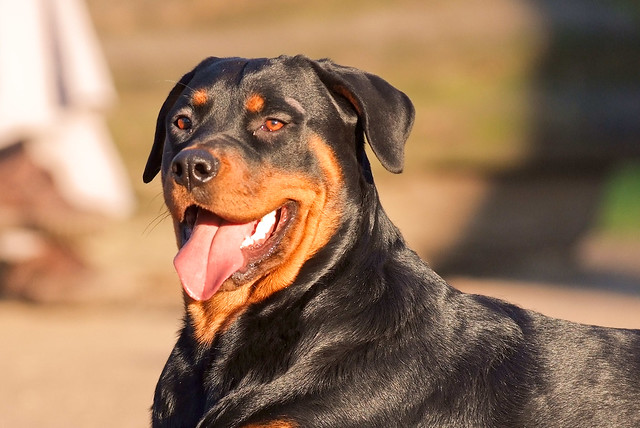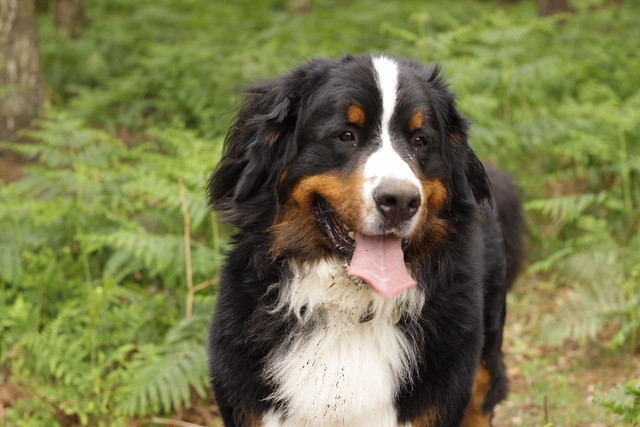 |
| Photo by arne.list |
The German Rottweiler can trace its roots as far as back as the Roman Empire and is considered by many to be one of the oldest herding dogs. The Rottweiler was used for various activities in different periods of history. In ancient times. the Rottweiler was used to herd and protect livestock, while in modern times was used primarily as a guard dog by militaries and police. Thus, the Rottweiler is a multi-faceted breed capable of performing various tasks and is very smart, loyal, eager to work, and is very confident.
can trace its roots as far as back as the Roman Empire and is considered by many to be one of the oldest herding dogs. The Rottweiler was used for various activities in different periods of history. In ancient times. the Rottweiler was used to herd and protect livestock, while in modern times was used primarily as a guard dog by militaries and police. Thus, the Rottweiler is a multi-faceted breed capable of performing various tasks and is very smart, loyal, eager to work, and is very confident.
Now, there are two basic differences between the kennel organizations like the AKC and ADRK. In the early 20th century, Germany had a few existing Rottweiler clubs covering the span of Germany, and it was in the 20's when they all came together to form the Allgemeiner Deutscher Rottweiler Klub (ADRK), i.e. General German Rottweiler Klub. Now, this organization has for almost 100 years now maintained a strict standard and guidelines to what the Rottweiler should be, as after all the Rottweiler is German and they wanted to preserve the Rottweiler for what it is (a working dog), and thus to this day have the best Rottweilers. In Germany, one cannot simply just breed any Rottweiler they like, be it a Rottweiler with papers and a Rottweiler without papers, like you can in America, but instead there is a procedure to it.
If you have ever looked at an import German (Pink Paper) pedigree, you will notice that there is a detailed paragraph for every Rottweiler in that dog's pedigree. These paragraphs are official "critiques" of the Rottweiler given by certified ADRK judges, These critiques are given when you take your Rottweiler to Zuchttauglichkeitsprufung (called the ZTP or BST) which translates to "breeding suitability test," and it officially certifies that a Rottweiler is acceptable as breeding stock. In Germany, a Rottweiler must meet this degree before being bred and hence, is the affirmation that this particular Rottweiler is within the standard and is an ambassador for the breed. This sort of "screening", if you will, helps weed out weak genetics and assures that the breed of Rottweilers will only continue to get better. The ZTP also tests the dogs working ability, because a Rottweiler not capable of working is not a Rottweiler. He just falls into the group of all other Molossoid breeds and isn't distinguishable.
If I can put it into an analogy, it would be like if you saw a really sporty looking car on the street being passed by a Geo. The car may look like it's fast, but in reality, it isn't. The Rottweiler is the same, you might see one that may look really nice, but if he can't do what he is naturally intended to do, which is to work, then he isn't a true Rottweiler. Germans test the dogs working ability with Schutzhund. Schutzhund is like the police dog training that most people have seen, consisting of the dog biting a man wearing a padded suit with a bite sleeve. But, it is a little more thorough than just biting. Schutzhund consists of 3 parts: Obedience, Protection, and Tracking.
Now, I can go on speaking about Schutzhund for the next hour, but the gist of it is that it makes the Rottweiler completely controllable, confident, and ready to do any command that is asked by his owner. The obedience part does just this, the Rottweiler is tested in various ways on his ability to listen and perform tasks that are commanded by his owner. The Protection part, falls in line with obedience, as the Rottweiler is commanded to find the perpetrator (in Schutzhund he is hiding behind Teepee-like blinds), get up as close as possible to the perp and consistently bark to acknowledge to his owner that he has found him and to await the owners commands. Lastly, the tracking not only tests the Rottweiler's scenting ability but his overall mental soundness and ability to find items precisely. This is just the very basic explanation of it, I'll write a very thorough article on Rottweilers and Schutzhund shortly.
So, the ZTP critiques the dog's look or confirmation, and also these 3 phases of Schutzhund. Point being, this sort of testing is paramount if you want to preserve the integrity of a breed like the Rottweiler.
In America on the other hand, there is none of this. There was a large influx of Rottweilers being imported from throughout Germany and Europe and being registered in the 70s and 80s, that at one point the Rottweiler was one of the most registered dogs in the AKC in the 80's. AKC almost has zero Rottweiler-specific regulations when it comes to breeding like the ADRK has, so for the last 30-40 years, anyone with a Rottweiler was able to breed to any other Rottweiler, not taking into consideration the German standard, and thus resulted in the American Rottweiler.
Now, one of the first things you will see when placing a German Rottweiler side by side an American Rottweiler is that the German Rottweiler has a tail. Docking tails have become part of the German standard in the early 2000's and are outlawed in most of Europe. In America, the vast majority of breeders still do it as it is still legal. The separate point also being, that if you encounter Rottweiler breeders saying that they breed German Rottweilers, but you see the tails cropped, they are obviously not following the ADRK standard and are not breeding German Rottweilers.
side by side an American Rottweiler is that the German Rottweiler has a tail. Docking tails have become part of the German standard in the early 2000's and are outlawed in most of Europe. In America, the vast majority of breeders still do it as it is still legal. The separate point also being, that if you encounter Rottweiler breeders saying that they breed German Rottweilers, but you see the tails cropped, they are obviously not following the ADRK standard and are not breeding German Rottweilers.
Another difference you will immediately see is the sheer size difference between the two. German Rottweilers tend to be a lot larger and more compact than typical Rottweilers. German Rottweilers have heavier bones, thicker necks, wider chests, bigger headpieces, more pronounced stops (arched foreheads), shorter muzzles, deeper chests, and won't have as long legs like American Rottweilers.
The German Rottweiler also tends to learn a lot quicker than American Rottweilers and has inherent guard instincts that are more pronounced than typical Rottweilers. The German Rottweiler as well will have more pronounced and a lot darker eye and mouth pigmentation.
This was just a general introduction to the differences between the real German Rottweiler, and the rest. If you encounter someone proposing that his Rottweiler is a German Rottweiler, first ask who his parents or grandparents are and Google their names to see if they are real ADRK registered German Rottweilers. And of course, don't ask them this if you see that he has a cropped tail, as more likely than not, he will not be a German Rottweiler.
If you enjoyed this article, and enjoy Rottweilers in general, please make sure to visit our website and see pictures of our beautiful Rottweilers, our adorable puppies pictures, about us as German Rottweiler breeders, and a lot more! http://www.vbrott.com Article Source: EzineArticles |











